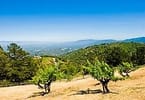If you are into tracking your food from farm to table, you will be ecstatic with the Wine Trail within a drive distance from Halifax. Weather permitting, visitors to the vineyards can walk through rows of grapes, inspect the leaves, test the soil and comment upon the trellising of the vines; the vineyard owners and managers are delighted that you are interested.
Up Close a Perséinlech
Nova Scotia (NS) is prepared to stand toe-to-toe with French wines and because the people making the wines are Canadian, they are not making the statement because they are bold or being pushy – they are purely stating a FACT.
NS grape growing started in the 17th century; however a producing winery is first documented in 1979 by Roger Dial who started the Grand Pre Winery and is the founder of Appellation America. In the 1980s Jans Jost began to cultivate wines at the Jost Vineyards on the Malagash Peninsula. Other wineries slowly opened and in 2003 the Wine Association of Nova Scotia (WANS) was started.
From sparkling wines to bold reds, crisp whites and luscious Ice-wines, this part of the world is making incredibly delicious, fruit – forward liquid experiences that are memorable and value-priced. The only problem may be access. Because of small production, the Nova Scotia wines are not widely distributed throughout the US or Europe. Actually this is good news as it presents the perfect reason to visit this beautiful and relatively underdeveloped part of Canada.
Happy Bubbles
Sparkling wine makers are delighted with the NS climate. The warm summers and the temperate influenced by the Atlantic Ocean creates a cool growing season and the grapes are able to develop an intensity while still retaining the acidity required for balance and structure.
The NS white wines are bright, crisp and aromatic with a touch of acidity for balance and character. The hybrid grapes used for the whites include L’Acadie Blanc, Seyval Blanc, Vidal and New York Muscat with success showing up with Chardonnay, Ortega and Riesling. The whites are perfectly paired with seafood – think about lobster, scallops and salmon.
The red wines are well-rounded, full-bodied and show low tannins. Varietals include Lucie Kuhlmann, Baco Noir, Marechal Foch and Leon Millot. Typically earthy, smoky and very – berry they pair well with gamey red meat and stews.
The temperature is also ideal for Ice-wine. The grapes for this delicious beverage are usually harvested at night between late November and late December when temperatures range between -8 and -10 degrees C. This wine requires slow fermentation to produce a complex, full-bodied dessert wine which is high in sugar and flavor with a balanced acidity that offers hints of tangerine, apricot and melon. The Ice-wine varieties are Vidal, Ortega and New York Muscat.
More About the Grapes
1. L’Acadie Blanc. An early ripening hybrid created in a Petri dish by crossing Seyve-Villard and Seibel. Not a sure-fire winner at birth, 10 vines were sent to NS and to everyone’s surprise, the grapes thrived in the cool, maritime climate. It was released as a wine at Grand Pre Winery (1970s) and called L’Acadie Blanc in honor of the region’s colonial heritage. Today it is an excellent expression of NS wines and frequently compared to either Chardonnay (body and texture) or Sauvignon Blanc (grassy, often citric aroma).
• Pair with lobster bisque, seafood Newburg, baked crab dip or Coquilles Saint Jacques.
2. Seyval Blanc. Also produced in a Petri dish, this hybrid was designed to do battle against the root louse phylloxera that was imported to Britain and France by botanists bringing cuttings from North America. Plant breeders wanted to take the desirable characteristics of phylloxera resistant plantings from North America grapevines and breed them with the desirable traits of Vitis vinifera vines.
Seyval Blanc was released in 1921 in Saint Vallier, Drome, France. It is a cross of two Seibel grape varieties and named after the French viticulturist Albert Seibel who is known for his work developing phylloxera-resistant varieties.
Crisp and clean, the grape produces light to medium-bodied white wines with citrus aromas and fruit flavors.
• Enjoyed as an aperitif, with mussels or with a light white fish such as sole.
3. Vidal. This is a late harvesting grape with moderate winter hardiness and disease resistance. It lends itself to ice wine production and it is used primarily for this purpose in NS.
• Pairings: On its own (chilled) as an aperitif or enjoyed with chicken liver parfait, sashimi, or Asian vegetable rolls.
4. New York Muscat. This hardy and disease resistant grape is low-yielding but highly aromatic. Makes excellent ice wine.
• Pair with spicy oriental dishes, lobster, and heavy stews. It is also the best wine for steaming mussels, giving them a wonderful flavor.
5. Lucie Kuhlmann. This is a grape that is vigorous, productive and winter-ready but may be susceptible to bunch rot and powdery mildew. Tends to have high acids and a herbaceous character.
• Pair with wild boar tenderloin and blackberry conserve or roasted rack of lamb with spiced berry sauce.
6. Baco Noir. Another Petri dish hybrid, this grape is produced from a cross of Vitis vinifera Folle blanche (used to make brandies in Armagnac) a French wine grape and an unknown variety of Vitis riparia that is indigenous to North America. It was bred in 1902 and commercially released in 1920.
A delicate grape, it is susceptible to black rot, crown gall, Botrytis bunch rot, Eutypa dieback and powdery mildew as well as anthracnose, downy mildew, Phomopsis and leaf spot as well as Botrytis bunch rot.
It is a deeply colored wine that is low in tannin and may have a herbaceous taste and can have Bordeaux-like qualities. It blends well with varieties of less color. Complex fruit flavors of black cherries, blackberries and prunes with herbal notes of black pepper, licorice, cinnamon and eucalyptus distinguish the Baco. Bring to a barbeque or enjoy with aged Cheddar cheese, or beef with horseradish or mustard.
7. Marechal Foch. This is an industry standard for red wine grapes. Winter-ready, disease resistant, it is dark red-violet in color and delivers a taste that is intense.
• Pair with tuna niçoise or jambalaya.
8. Leon Millot. Dark skinned, this French-American hybrid ripens early in the vineyard. It is light to medium bodied with a deep color and very-berry aromas – think raspberries and cherries with a subtle suggestion of white pepper. Light-bodied and dry, it produces a gentle mint chocolate finish.
• Pair with spaghetti bolognaise.
9. Ortega. Named after the Spanish philosopher Jose Ortega y Gasset, it was introduced in Bavaria (1970s). This grape variety does well in cooler temperatures and generally low in acidity; however, it is susceptible to fungal diseases and coulure – have limited its use. It is considered to be aromatic, crisp and refreshing with a bold body. Offers peach and floral aromatics and is similar to Muscat.
• Pair with asparagus and oysters
Where to Taste
1. Luckett Vineyards.
Located in Gaspereau Valley, the winery enjoys fertile terroir along with incredible views overlooking the Minas Basin and Blomidon. The tidal airflow from the Bay of Fundy offers the grapes a mild temperature throughout the year and prevents late frosts in the early spring and early frosts in the fall.
Owned and operated by Pete Luckett, this vineyard and tasting /dining room, offers visitors a thorough introduction to the wide variety of Luckett wines and, a few lucky visitors may have the opportunity to meet and talk with Luckett who enjoys sharing his non-traditional UK background. A school dropout turned successful entrepreneur, Luckett’s’ charm and intelligence brought him from being a stall owner in Nottingham, England, to being a renowned developer of a supermarket chain and noted wine maker.
To Taste:
Tidal Bay. 2014. A blend of L’Acadie (50 percent), Ortega (45 percent) and Traminette (5 percent). Fermented in stainless steel.
Tidal Bay is the designation that refers to the province’s signature wine, or appellation, and is produced by all 12 members of the Winery Association of Nova Scotia. To receive this distinction the wines are held to strict new grape-growing and winemaking standards. All wines must be made from specific grape varieties and include 100 percent NS grown grapes. The wines are evaluated by an independent tasting panel to make sure they conform to the Tidal Bay style and to certify quality. The wines are distinguished by a fresh, complex nose and crisp, bright flavor that delivers a fullness that lingers.
To the eye, clear and bright as a summer day; to the nose, lemon, limes, apples and cantaloupe; crisp and elegant on the tongue with a clean and elegant finish. Pair with NS scallops, local goat cheese or sushi. For additional information, c Klick hei.
2. Benjamin Bridge
The Benjamin Bridge founder, Gerry McConnell – who made a fortune in the gold-mining business, and his late wife Dara Gordon, invested $5 million to start the company with most of the money directed to the vineyard. In the Gaspereau Valley on the Bay of Fundy, McConnell found a cool climate reminiscent to the Champagne region of France. Located near Wolfville the area is a subregion of the Annapolis Valley. It is here that Benjamin Bridge hand-crafted fine wines and world-class Methode Classique sparkling wines are produced.
To Taste:
Vero Tidal Bay. 2013. Chardonnay (60 percent), L’Acadie Blanc (30 percent), Riesling (10 percent). Aged in stainless steel for 5-6 months; 3-4 years in the bottle.
Almost transparent with a slight golden hue to the eye; to the nose –hints of lemon and lime, orange peel and peach, kiwi and white flowers; to the palate slight minerality combined with citrus and flowers. Delicious slightly tart finish that is crisp and elegant. Perfect as an aperitif or with oysters.
Nova 7. 2014. Nova Scotia grapes (100 percent). Classic champagne varieties of Chardonnay, Pinot Noir and Pinot Meunier. Berries are hand-picked in small baskets, gently pressed and bottled for extended aging on their lees.
This proprietary blend conceived by Peter Gamble receives applause. Inspired by the European tradition of lightly sparkling, off-dry wines, it is considered to be uniquely NS as it is a mix of lively acidity and is elegantly perfumed. This light (6.5 percent alcohol) wine is made in the Italian Moscato d’Asti tradition but is less sweet.
To the eye, pale rose to coral. The nose embraces a hint of white roses, water lilies and orange blossoms and perhaps a touch of lychee. Ruby red grapefruit on the tongue with suggestions of blood orange and star fruit. The finish is dense and bright. Pair with Crepe Suzettes, salmon with fresh salsa.
Getting to the Wines
Yes. You can rent a car, pull up a map, and find your own way to the multiple vineyards within a drive distance from Halifax. This is a really bad idea! Why! Because – drinking and driving is a no-no and the wines are so delicious and the vineyards are so attractive, and the dining options are so fresh and appealing, there is no way that anyone wants to abstain from enjoying the tasting rooms and dining options (many open exclusively through Grape Escapes).
So. Contact Susan Downey Lim, the CEO and Tour Director of Grape Escapes, and tell her what you and your significant others want to do and see and taste. From a private tour to joining a group, the options are limited only by your wishes and whims.
Lim comes to the wine business with a background in wine boutiques, restaurants and wine tourism. She has accumulated her knowledge through wine industry experiences in Australia, New Zealand, Italy and Canada. Currently she is prepping for her sommelier certification from the Canadian Association of Professional Sommeliers. For additional information, Klick hei.
Getting to Halifax
Air Canada flies to Halifax and offers access from domestic and international departure cities. For additional information, Klick hei.
WAT VUN DESEN ARTIKEL WEI HUELEN:
- The warm summers and the temperate influenced by the Atlantic Ocean creates a cool growing season and the grapes are able to develop an intensity while still retaining the acidity required for balance and structure.
- Nova Scotia (NS) is prepared to stand toe-to-toe with French wines and because the people making the wines are Canadian, they are not making the statement because they are bold or being pushy – they are purely stating a FACT.
- This wine requires slow fermentation to produce a complex, full-bodied dessert wine which is high in sugar and flavor with a balanced acidity that offers hints of tangerine, apricot and melon.






















